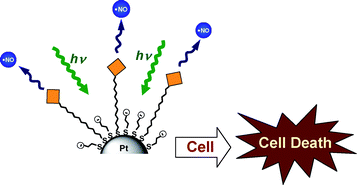Nitric oxide photocaging platinum nanoparticles with anticancer potential
Abstract
In this contribution we report the design, fabrication and properties of hydrosoluble

* Corresponding authors
a
Dipartimento di Scienze Chimiche, Università di Catania, Catania, Italy
E-mail:
ssortino@unict.it
b Dipartimento di Scienze Microbiologiche Genetiche e Molecolari, Università di Messina, Messina, Italy
c Istituto per lo Studio dei Materiali Nanostrutturati, ISMN-CNR, c/o Dipartimento di Chimica Inorganica Analitica e Chimica Fisica, Università di Messina, Messina, Italy
In this contribution we report the design, fabrication and properties of hydrosoluble

 Please wait while we load your content...
Something went wrong. Try again?
Please wait while we load your content...
Something went wrong. Try again?
M. Barone, M. T. Sciortino, D. Zaccaria, A. Mazzaglia and S. Sortino, J. Mater. Chem., 2008, 18, 5531 DOI: 10.1039/B809121H
To request permission to reproduce material from this article, please go to the Copyright Clearance Center request page.
If you are an author contributing to an RSC publication, you do not need to request permission provided correct acknowledgement is given.
If you are the author of this article, you do not need to request permission to reproduce figures and diagrams provided correct acknowledgement is given. If you want to reproduce the whole article in a third-party publication (excluding your thesis/dissertation for which permission is not required) please go to the Copyright Clearance Center request page.
Read more about how to correctly acknowledge RSC content.
 Fetching data from CrossRef.
Fetching data from CrossRef.
This may take some time to load.
Loading related content
